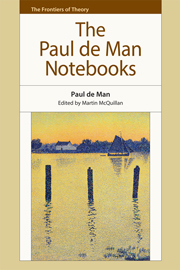Book contents
- Frontmatter
- Contents
- Series Editor's Preface
- Acknowledgements
- Dedication
- Introduction: ‘The Unimaginable Touch of Time’: The Public and Private in the Notebooks of Paul de Man
- PART I Texts
- 1 The Drawings of Paul Valéry (1948)
- 2 Jacques Villon (1952)
- 3 Graduate Essay on Keats (1954)
- 4 Postdoctoral Essay on Symbolism (c. 1960)
- 5 Introduction to Madame Bovary (1965)
- 6 Introduction to The Portable Rousseau (1973)
- 7 On Reading Rousseau (1977)
- 8 Translator's Introduction to “Rousseau and English Romanticism” (1978)
- 9 Rousseau and English Romanticism (1978)
- 10 Introduction to Studies in Romanticism (1979)
- 11 Hommage à Georges Poulet (1982)
- 12 A Letter from Paul de Man (1982)
- 13 Reply to Raymond Geuss (1983)
- 14 Interview with Robert Moynihan (1984)
- PART II Translations
- PART III Teaching
- PART IV Research
- Appendix. The Notebooks of Paul de Man 1963–83
- Bibliography
- Index of Names
1 - The Drawings of Paul Valéry (1948)
from PART I - Texts
Published online by Cambridge University Press: 05 December 2014
- Frontmatter
- Contents
- Series Editor's Preface
- Acknowledgements
- Dedication
- Introduction: ‘The Unimaginable Touch of Time’: The Public and Private in the Notebooks of Paul de Man
- PART I Texts
- 1 The Drawings of Paul Valéry (1948)
- 2 Jacques Villon (1952)
- 3 Graduate Essay on Keats (1954)
- 4 Postdoctoral Essay on Symbolism (c. 1960)
- 5 Introduction to Madame Bovary (1965)
- 6 Introduction to The Portable Rousseau (1973)
- 7 On Reading Rousseau (1977)
- 8 Translator's Introduction to “Rousseau and English Romanticism” (1978)
- 9 Rousseau and English Romanticism (1978)
- 10 Introduction to Studies in Romanticism (1979)
- 11 Hommage à Georges Poulet (1982)
- 12 A Letter from Paul de Man (1982)
- 13 Reply to Raymond Geuss (1983)
- 14 Interview with Robert Moynihan (1984)
- PART II Translations
- PART III Teaching
- PART IV Research
- Appendix. The Notebooks of Paul de Man 1963–83
- Bibliography
- Index of Names
Summary
In the game he plays against the World and against himself, Valéry has always had but one adversary: Chance. From Chance he must win what he sees, what he thinks, what he is in the moment.
To open one's eyes, to focus them on some object, is “to throw the dice.” Each throw offers another side of things, each glance determines a possible aspect of Appearance. What is seen is only a special case. How could a mind entirely oriented toward the exercise of itself, a mind which aspires to the universal – how could such a mind submit to such a restriction of its combinations and of its powers? It escapes only by detachment. It seals itself against what comes to it from the visible world and falls back on its own chaos. Its contradictions, its incoherences, its accidents are its resources. Upon them it imposes its order; indeed its object is to exhaust its possibilities, to apprehend itself in its perpetual variation.
Such an attitude implies unremitting application, discipline, and constraint. Immured within himself, the solitary concentrates – he draws the substance of his speculation. Three or four ideas create the sphere in which he moves – his interior space. To realize what he can do, he needs only rigor and nakedness. The most impersonal site, an empty room, a slanting sunbeam, a few papers on a table – are enough. The walls vanish. The shadows cast there follow each other without his noticing them. Only the abstract figures he draws with a pure white piece of chalk have a reality in his eyes. At the heart of this world of symbols and relations, he gives himself up to his operations and his tactics; he multiplies his ventures, his deductions, his conjectures; he approaches certainty – and loses it; he doubts – and waits. Hypotheses swarm. On all sides, prospects open; limitless consequences, sets of reasonings, radiate around him to the vanishing point; while on the brink of the intelligible, in that imaginary space, glow other systems, loom other truths.
- Type
- Chapter
- Information
- The Paul de Man Notebooks , pp. 25 - 37Publisher: Edinburgh University PressPrint publication year: 2014



